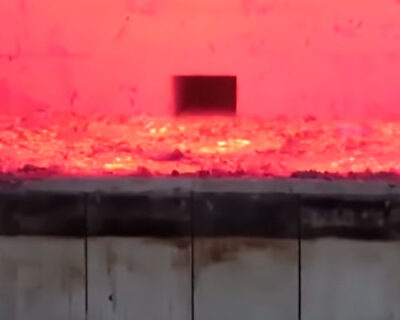The aluminum smelting method for foundry includes bach smelting, semi-bach smelting, semi-continuous smelting and continuous smelting method.
Batch Smelting Method
The batch smelting method is smelting with one smelting time. After one charge is loaded into the furnace, it is melted, slagging off, the chemical composition is adjusted, and then the flux refining treatment is carried out, and the furnace is discharged after the temperature is appropriate. After the charge is discharged at one time, no excess charge is allowed, and then the next charge is loaded.
This batch smelting method is suitable for the production of aluminum alloy products, and it can ensure the uniformity and accuracy of the alloy chemical composition.
Semi-batch Smelting Method
The difference between the semi-batch smelting method and the batch smelting method is that the charge is not all discharged when the furnace is discharged, and one-fifth to one-fourth of the liquid material is left, which is then loaded into the next melting furnace charge for melting.
The advantage of this semi-batch smelting method is that the added metal furnace charge is immersed in the liquid material, thereby accelerating the melting speed and reducing the burning loss. The inclusions sunk in the furnace can be left in the furnace and will not be mixed into the molten melt, thereby reducing non-metallic inclusions in the ingot. At the same time, the temperature in the furnace does not fluctuate much, which can extend the life of the furnace and help improve the furnace life. However, the disadvantage of this method is that there is always residual material in the furnace, and the residual material stays in the furnace for too long, which is easy to produce coarse grains and affect the quality of the ingot. Semi-batch smelting is suitable for the production of master alloys and pure aluminum with low product quality requirements and a small cracking tendency.
Semi-continuous Smelting Method
The semi-continuous smelting method is similar to the semi-batch smelting method. Each time the output is 1/3, you can add the next molten drink charge. The difference from the semi-batch smelting method is that most of the liquid material left in the furnace is not much material discharged from the furnace each time. The newly added materials can all be stirred into the melt, so that each discharge and the addition of the materials are continuous with each other.
This semi-continuous smelting method is suitable for smelting debris in a double-hearth furnace. As the charge is immersed in the liquid, not only can the burning loss be reduced, but also the melting speed can be accelerated.
Continuous Smelting Method
The continuous smelting method feeds continuously and intermittently discharges from the furnace. The continuous smelting method has little flexibility and is only used for the smelting of pure aluminum. For aluminum alloy smelting, the residence time of the melt in the furnace should be as short as possible. Because the residence time of the melt is extended, especially at higher smelting temperatures, a large number of non-spontaneous crystal nuclei will be resurrected, causing coarse ingot grains, and increasing metal suction, which will increase the non-metallic inclusions and gas content of the melt. A large amount of solid material is added to the upper liquid material, which seriously pollutes the metal, which is undesirable for aluminum alloy smelting.
Therefore, the batch smelting method is the most suitable smelting method for aluminum alloy production.

